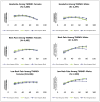Temporomandibular joint and muscle disorder-type pain and comorbid pains in a national US sample
- PMID: 21837286
- PMCID: PMC3807573
Temporomandibular joint and muscle disorder-type pain and comorbid pains in a national US sample
Abstract
Aims: To compare prevalences of self-reported comorbid headache, neck, back, and joint pains in respondents with temporomandibular joint and muscle disorder (TMJMD)-type pain in the 2000-2005 US National Health Interview Survey (NHIS), and to analyze these self-reported pains by gender and age for Non-Hispanic (NH) Whites (Caucasians), Hispanics, and NH Blacks (African Americans).
Methods: Data from the 2000-2005 NHIS included information on gender, age, race, ethnicity, education, different common types of pain (specifically TMJMD-type, severe headache/migraine, neck, and low back pains), changes in health status, and health care utilization. Estimates and test statistics (ie, Pearson correlations, regressions, and logistic models) were conducted using SAS survey analysis and SUDAAN software that take into account the complex sample design.
Results: A total of 189,977 people (52% female and 48% males, 73% NH Whites, 12% Hispanic, 11% NH Blacks, and 4% "Other") were included. A total of 4.6% reported TMJMD-type pain, and only 0.77% overall reported it without any comorbid headache/migraine, neck, or low back pains; also 59% of the TMJMD-type pain (n = 8,964) reported ⋝ two comorbid pains. Females reported more comorbid pain than males (odds ratio [OR] = 1.41, P < .001); Hispanic and NH Blacks reported more than NH Whites (OR = 1.56, P <.001; OR= 1.38, P <.001, respectively). In addition, 53% of those with TMJMD-type pain had severe headache/migraines, 54% had neck pain, 64% low back pain, and 62% joint pain. Differences in gender and race by age patterns were detected. For females, headache/migraine pain with TMJMD-type pain peaked around age 40 and decreased thereafter regardless of race/ethnicity. Neck pain continued to increase up to about age 60, with a higher prevalence for Hispanic women at younger ages, and more pronounced in males, being the highest in the non-Whites. Low back pain was higher in Black and Hispanic females across the age span, and higher among non-White males after age 60. Joint pain demonstrated similar patterns by race/ethnicity, with higher rates for Black females, and increased with age regardless of gender.
Conclusion: TMJMD-type pain was most often associated with other common pains, and seldom existed alone. Two or more comorbid pains were common. Gender, race, and age patterns for pains with TMJMD-type pain resembled the specific underlying comorbid pain.
Figures



References
-
- Plesh O, Crawford PB, Gansky SA. Chronic pain in a biracial population of young women. Pain. 2002;99:515–523. - PubMed
-
- Gansky SA, Plesh O. Widespread pain and fibromyalgia in a biracial cohort study of young women. J Rheumatol. 2007;34:810–817. - PubMed
-
- NationalCenter for Health Statistics. Data File Documentation, National Health Interview Survey, 2004 (machine readable data file and documentation) National Center for Health Statistics, Centers for Disease Control and Prevention; Hyattsville, Maryland: 2005.
Publication types
MeSH terms
Grants and funding
LinkOut - more resources
Full Text Sources
Medical
